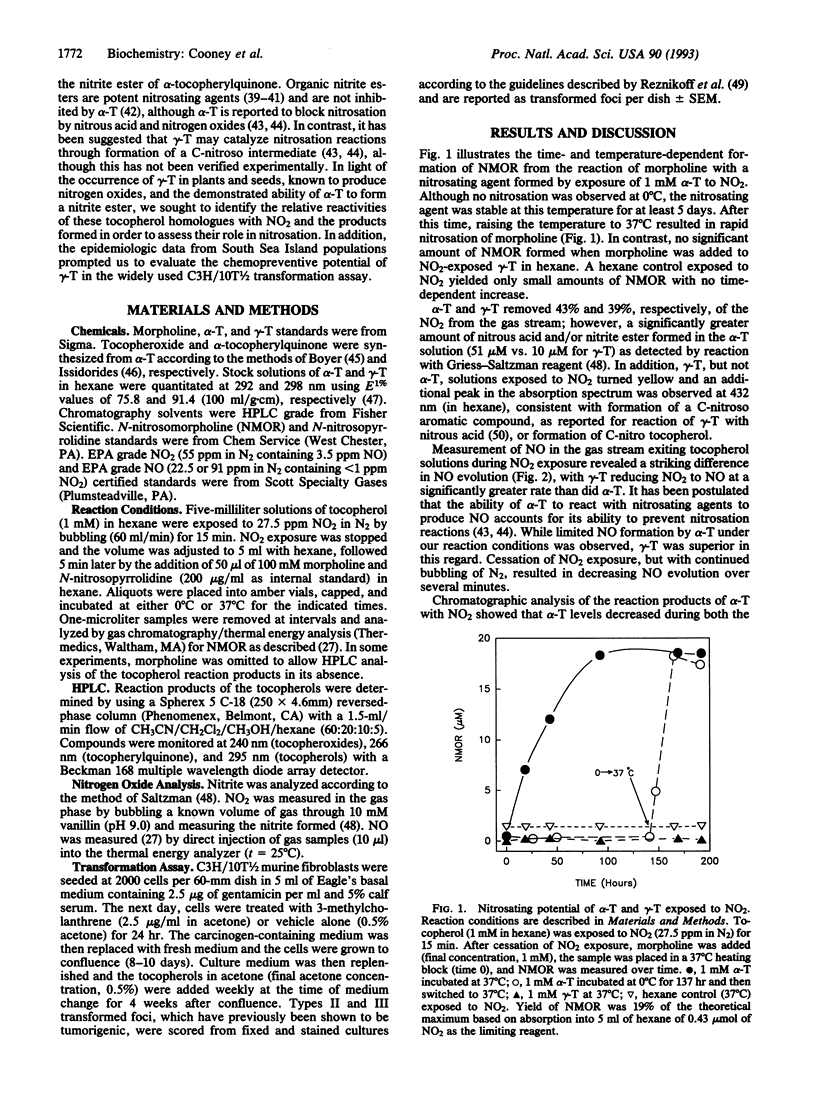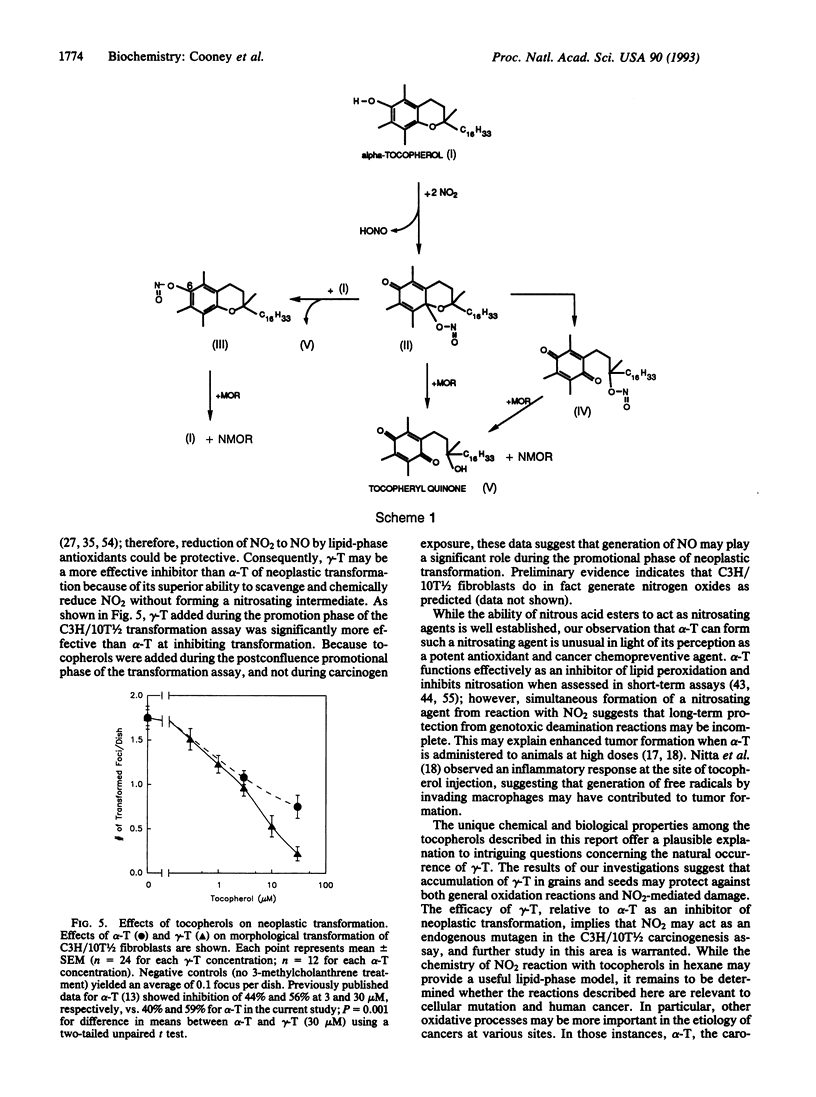Abstract
In the vitamin E group, alpha-tocopherol is generally considered to be the most potent antioxidant with the highest vitamin bioactivity, yet gamma-tocopherol is produced in greater amounts by many plants and is the principal tocopherol in the United States diet. This report describes a fundamental difference in the chemical reactivities of alpha-tocopherol and gamma-tocopherol with nitrogen dioxide (NO2), which leads to the formation of a nitrosating agent from alpha-tocopherol, but not from gamma-tocopherol. Nitric oxide (NO) is a major product of the reaction of gamma-tocopherol with NO2, while alpha-tocopherol reacts with NO2 to form an intermediate tocopheroxide analogue. The biological significance of gamma-tocopherol is suggested by limited epidemiological data as well as the observation that it is a more potent inhibitor than alpha-tocopherol of neoplastic transformation during the postinitiation phase in 3-methylcholanthrene-treated C3H/10T1/2 murine fibroblasts. This latter property suggests the superiority of gamma-tocopherol in a mammalian biological assay and a role for endogenous NO production in promotion of neoplastic transformation.
Full text
PDF




Selected References
These references are in PubMed. This may not be the complete list of references from this article.
- Arroyo P. L., Hatch-Pigott V., Mower H. F., Cooney R. V. Mutagenicity of nitric oxide and its inhibition by antioxidants. Mutat Res. 1992 Mar;281(3):193–202. doi: 10.1016/0165-7992(92)90008-6. [DOI] [PubMed] [Google Scholar]
- Barinaga M. Is nitric oxide the "retrograde messenger"? Science. 1991 Nov 29;254(5036):1296–1297. doi: 10.1126/science.1962189. [DOI] [PubMed] [Google Scholar]
- Behrens W. A., Madère R. Alpha- and gamma tocopherol concentrations in human serum. J Am Coll Nutr. 1986;5(1):91–96. doi: 10.1080/07315724.1986.10720116. [DOI] [PubMed] [Google Scholar]
- Benedict W. F., Wheatley W. L., Jones P. A. Inhibition of chemically induced morphological transformation and reversion of the transformed phenotype of ascorbic acid in C3H/10T 1/2 cells. Cancer Res. 1980 Aug;40(8 Pt 1):2796–2801. [PubMed] [Google Scholar]
- Bertram J. S., Pung A., Churley M., Kappock T. J., 4th, Wilkins L. R., Cooney R. V. Diverse carotenoids protect against chemically induced neoplastic transformation. Carcinogenesis. 1991 Apr;12(4):671–678. doi: 10.1093/carcin/12.4.671. [DOI] [PubMed] [Google Scholar]
- Bieri J. G., Evarts R. P. Gamma tocopherol: metabolism, biological activity and significance in human vitamin E nutrition. Am J Clin Nutr. 1974 Sep;27(9):980–986. doi: 10.1093/ajcn/27.8.980. [DOI] [PubMed] [Google Scholar]
- Bieri J. G., Evarts R. P. Tocopherols and fatty acids in American diets. The recommended allowance for vitamin E. J Am Diet Assoc. 1973 Feb;62(2):147–151. [PubMed] [Google Scholar]
- Bieri J. G., Evarts R. P. Vitamin E activity of gamma-tocopherol in the rat, chick and hamster. J Nutr. 1974 Jul;104(7):850–857. doi: 10.1093/jn/104.7.850. [DOI] [PubMed] [Google Scholar]
- Borek C., Ong A., Mason H., Donahue L., Biaglow J. E. Selenium and vitamin E inhibit radiogenic and chemically induced transformation in vitro via different mechanisms. Proc Natl Acad Sci U S A. 1986 Mar;83(5):1490–1494. doi: 10.1073/pnas.83.5.1490. [DOI] [PMC free article] [PubMed] [Google Scholar]
- Busse R., Mülsch A. Induction of nitric oxide synthase by cytokines in vascular smooth muscle cells. FEBS Lett. 1990 Nov 26;275(1-2):87–90. doi: 10.1016/0014-5793(90)81445-t. [DOI] [PubMed] [Google Scholar]
- Challis B. C., Edwards A., Hunma R. R., Kyrtopoulos S. A., Outram J. R. Rapid formation of N-nitrosamines from nitrogen oxides under neutral and alkaline conditions. IARC Sci Publ. 1978;(19):127–142. [PubMed] [Google Scholar]
- Cooney R. V., Ross P. D., Bartolini G. L. N-nitrosation and N-nitration of morpholine by nitrogen dioxide: inhibition by ascorbate, glutathione and alpha-tocopherol. Cancer Lett. 1986 Jul;32(1):83–90. doi: 10.1016/0304-3835(86)90042-x. [DOI] [PubMed] [Google Scholar]
- Dillard C. J., Gavino V. C., Tappel A. L. Relative antioxidant effectiveness of alpha-tocopherol and gamma-tocopherol in iron-loaded rats. J Nutr. 1983 Nov;113(11):2266–2273. doi: 10.1093/jn/113.11.2266. [DOI] [PubMed] [Google Scholar]
- Diplock A. T. The role of vitamin E in biological membranes. Ciba Found Symp. 1983;101:45–55. doi: 10.1002/9780470720820.ch4. [DOI] [PubMed] [Google Scholar]
- Henderson B. E., Kolonel L. N., Dworsky R., Kerford D., Mori E., Singh K., Thevenot H. Cancer incidence in the islands of the Pacific. Natl Cancer Inst Monogr. 1985 Dec;69:73–81. [PubMed] [Google Scholar]
- Hollstein M., Sidransky D., Vogelstein B., Harris C. C. p53 mutations in human cancers. Science. 1991 Jul 5;253(5015):49–53. doi: 10.1126/science.1905840. [DOI] [PubMed] [Google Scholar]
- Isomura K., Chikahira M., Teranishi K., Hamada K. Induction of mutations and chromosome aberrations in lung cells following in vivo exposure of rats to nitrogen oxides. Mutat Res. 1984 May;136(2):119–125. doi: 10.1016/0165-1218(84)90153-8. [DOI] [PubMed] [Google Scholar]
- Ji X. B., Hollocher T. C. Mechanism for nitrosation of 2,3-diaminonaphthalene by Escherichia coli: enzymatic production of NO followed by O2-dependent chemical nitrosation. Appl Environ Microbiol. 1988 Jul;54(7):1791–1794. doi: 10.1128/aem.54.7.1791-1794.1988. [DOI] [PMC free article] [PubMed] [Google Scholar]
- Klepper L. A. Nitric Oxide Emissions from Soybean Leaves during in Vivo Nitrate Reductase Assays. Plant Physiol. 1987 Sep;85(1):96–99. doi: 10.1104/pp.85.1.96. [DOI] [PMC free article] [PubMed] [Google Scholar]
- LOWRY T., SCHUMAN L. M. Silo-filler's disease; a syndrome caused by nitrogen dioxide. J Am Med Assoc. 1956 Sep 15;162(3):153–160. doi: 10.1001/jama.1956.02970200001001. [DOI] [PubMed] [Google Scholar]
- Loeppky R. N., Tomasik W., Millard T. G. Ester-mediated nitrosamine formation from nitrite and secondary or tertiary amines. IARC Sci Publ. 1984;(57):353–363. [PubMed] [Google Scholar]
- Marletta M. A., Yoon P. S., Iyengar R., Leaf C. D., Wishnok J. S. Macrophage oxidation of L-arginine to nitrite and nitrate: nitric oxide is an intermediate. Biochemistry. 1988 Nov 29;27(24):8706–8711. doi: 10.1021/bi00424a003. [DOI] [PubMed] [Google Scholar]
- McLaughlin P. J., Weihrauch J. L. Vitamin E content of foods. J Am Diet Assoc. 1979 Dec;75(6):647–665. [PubMed] [Google Scholar]
- Mirvish S. S., Babcook D. M., Deshpande A. D., Nagel D. L. Identification of cholesterol as a mouse skin lipid that reacts with nitrogen dioxide to yield a nitrosating agent, and of cholesteryl nitrite as the nitrosating agent produced in a chemical system from cholesterol. Cancer Lett. 1986 Apr;31(1):97–104. doi: 10.1016/0304-3835(86)90171-0. [DOI] [PubMed] [Google Scholar]
- Mirvish S. S., Ramm M. D., Sams J. P., Babcook D. M. Nitrosamine formation from amines applied to the skin of mice after and before exposure to nitrogen dioxide. Cancer Res. 1988 Mar 1;48(5):1095–1099. [PubMed] [Google Scholar]
- Moncada S., Palmer R. M., Higgs E. A. The discovery of nitric oxide as the endogenous nitrovasodilator. Hypertension. 1988 Oct;12(4):365–372. doi: 10.1161/01.hyp.12.4.365. [DOI] [PubMed] [Google Scholar]
- Nguyen T., Brunson D., Crespi C. L., Penman B. W., Wishnok J. S., Tannenbaum S. R. DNA damage and mutation in human cells exposed to nitric oxide in vitro. Proc Natl Acad Sci U S A. 1992 Apr 1;89(7):3030–3034. doi: 10.1073/pnas.89.7.3030. [DOI] [PMC free article] [PubMed] [Google Scholar]
- Nitta Y., Kamiya K., Tanimoto M., Sadamoto S., Niwa O., Yokoro K. Induction of transplantable tumors by repeated subcutaneous injections of natural and synthetic vitamin E in mice and rats. Jpn J Cancer Res. 1991 May;82(5):511–517. doi: 10.1111/j.1349-7006.1991.tb01880.x. [DOI] [PMC free article] [PubMed] [Google Scholar]
- Patnaik R. N., Nair P. P. Studies on the binding of d-alpha-tocopherol to rat liver nuclei. Arch Biochem Biophys. 1977 Jan 30;178(2):333–341. doi: 10.1016/0003-9861(77)90201-6. [DOI] [PubMed] [Google Scholar]
- Potischman N., Herrero R., Brinton L. A., Reeves W. C., Stacewicz-Sapuntzakis M., Jones C. J., Brenes M. M., Tenorio F., de Britton R. C., Gaitan E. A case-control study of nutrient status and invasive cervical cancer. II. Serologic indicators. Am J Epidemiol. 1991 Dec 1;134(11):1347–1355. doi: 10.1093/oxfordjournals.aje.a116037. [DOI] [PubMed] [Google Scholar]
- Pryor W. A., Lightsey J. W. Mechanisms of nitrogen dioxide reactions: initiation of lipid peroxidation and the production of nitrous Acid. Science. 1981 Oct 23;214(4519):435–437. doi: 10.1126/science.214.4519.435. [DOI] [PubMed] [Google Scholar]
- Reznikoff C. A., Bertram J. S., Brankow D. W., Heidelberger C. Quantitative and qualitative studies of chemical transformation of cloned C3H mouse embryo cells sensitive to postconfluence inhibition of cell division. Cancer Res. 1973 Dec;33(12):3239–3249. [PubMed] [Google Scholar]
- Selander H., Nilsson J. L. Vitamin E and air pollution. Nitrogen dioxide oxidation of -tocopherol model compound. Acta Pharm Suec. 1972 Apr;9(2):125–128. [PubMed] [Google Scholar]
- Tannenbaum S. R., Mergens W. Reaction of nitrite with vitamins C and E. Ann N Y Acad Sci. 1980;355:267–279. doi: 10.1111/j.1749-6632.1980.tb21345.x. [DOI] [PubMed] [Google Scholar]
- Toth B., Patil K. Enhancing effect of vitamin E on murine intestinal tumorigenesis by 1,2-dimethylhydrazine dihydrochloride. J Natl Cancer Inst. 1983 Jun;70(6):1107–1111. [PubMed] [Google Scholar]
- Tran K., Chan A. C. Comparative uptake of alpha- and gamma-tocopherol by human endothelial cells. Lipids. 1992 Jan;27(1):38–41. doi: 10.1007/BF02537056. [DOI] [PubMed] [Google Scholar]
- Wink D. A., Kasprzak K. S., Maragos C. M., Elespuru R. K., Misra M., Dunams T. M., Cebula T. A., Koch W. H., Andrews A. W., Allen J. S. DNA deaminating ability and genotoxicity of nitric oxide and its progenitors. Science. 1991 Nov 15;254(5034):1001–1003. doi: 10.1126/science.1948068. [DOI] [PubMed] [Google Scholar]
- Zhang L. X., Cooney R. V., Bertram J. S. Carotenoids enhance gap junctional communication and inhibit lipid peroxidation in C3H/10T1/2 cells: relationship to their cancer chemopreventive action. Carcinogenesis. 1991 Nov;12(11):2109–2114. doi: 10.1093/carcin/12.11.2109. [DOI] [PubMed] [Google Scholar]


